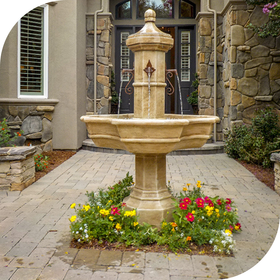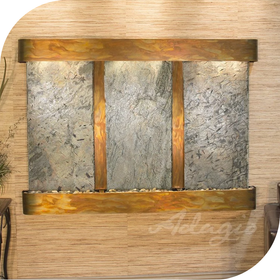Overview
Fountains can transform outdoor spaces into serene environments, serving as focal points that enhance aesthetics and attract wildlife. This article explores different types of fountains, including concrete and solar-powered options, and offers tips on designing gardens around them. Key elements include selecting complementary plants, creating pathways, and adding accessories like garden furniture. Regular maintenance and wildlife encouragement are essential for keeping fountains appealing and functional. Ultimately, a well-designed fountain can elevate your outdoor experience, making it a relaxing oasis.
Fountains play a pivotal role in transforming outdoor spaces into serene, harmonious environments. With a variety of options, from solar powered water features to traditional concrete fountains, incorporating a fountain as a centerpiece in your landscape design can elevate the aesthetic appeal of any garden or yard. This article delves into how to effectively design around your fountain, creating a stunning focal point that invites relaxation and enhances the sensory experience of your outdoor space.
Understanding the Appeal of Fountains
The allure of fountains lies not only in their visual beauty but also in the soothing sound of running water. Outdoor fountains serve as dynamic elements that can attract wildlife, enhance the ambiance, and create a sense of tranquility. Whether you're opting for a garden fountain, a solar water feature, or a luxurious ceramic bird bath, understanding the various types is crucial in selecting the right centerpiece for your design.
The Role of Fountains in Landscape Design
In landscape architecture, the placement of a fountain can be a game-changer. A well-positioned fountain in a garden creates a visual anchor that draws the eye and organizes spatial elements. Here’s how you can incorporate fountains into your design:
-
Layering Elements: Elevate the design by layering plants and materials around the fountain to create depth.
-
Creating a Soundscape: The gentle sound of water can mask unwanted noise, making your outdoor space more inviting.
-
Attracting Wildlife: Fountains, especially bird bath fountains, can lure in beautiful birds and butterflies, adding liveliness to your garden.
Choosing the Right Fountain for Your Space
When selecting your outdoor centerpiece, consider the overall theme of your landscape. Different fountains offer distinct aesthetics and functionalities. Let's explore various types:
Concrete Fountains
Concrete fountains are known for their durability and range of styles, from traditional to modern. They can be integrated seamlessly into formal garden designs or left to create a striking contrast in a more casual landscape.
Solar Water Features
For those looking for something eco-friendly, solar powered water features are an excellent choice. These solar water fountains harness sunlight to power the flow of water, making them cost-effective and sustainable. Additionally, they offer flexibility with placement since they do not require electrical outlets.
Bird Baths and Bird Bath Fountains
Incorporating a bird bath or a bird bath fountain not only enhances the visual appeal of your garden but also creates a habitat for birds. A ceramic bird bath or a concrete bird bath can stand out beautifully amidst flowering plants, while a solar bird bath fountain introduces movement and sound, attracting wildlife even more effectively.
Stone and Ceramic Bird Baths
Stone bird baths offer a timeless elegance and can blend well with natural surroundings. Alternatively, a ceramic bird bath can add vibrant colors and artistic flair to your garden design. The choice between the two depends on the look you are aiming for and how it complements your exterior water fountain.
Designing Your Garden Around the Fountain
Once you've chosen the perfect fountain for your outdoor space, the next step is designing around it. Here are some tips for achieving a cohesive look:
Establishing a Focal Point
Your fountain should be the standout feature of your garden. To emphasize this:
- Place the fountain in a central location or at the end of a pathway to draw the eye.
- Use lighting to highlight the fountain during the evening hours, creating a dazzling effect.
Selecting Complementary Plants
Consider incorporating a mix of foliage and flowers that will enhance the beauty of your fountain. Here are a few suggestions:
-
Low-growing plants: These can surround the base of the fountain and create an elegant frame.
-
Tall grasses: They can provide height and movement, softly swaying in the breeze beside your garden water features.
-
Colorful blooms: Plant vibrant flowers to add pops of color throughout the garden, complementing the style of the fountain.
Incorporating Pathways
Pathways leading to your fountain can enhance accessibility and draw attention to it. Different materials such as stone, gravel, or pavers can be used to create unique pathways that harmonize with both the fountain and surrounding landscape.
Creating Harmony With Accessories
Accessorizing around your fountain can add layers to your outdoor design. Here are a few accessory ideas:
Garden Furniture
Placing comfortable seating near your fountain allows you to enjoy its calming presence. Consider benches, chairs, or even hammocks that invite relaxation and enjoyment of your garden.
Decorative Stones and Pebbles
Positioning decorative stones or pebbles around the base of your fountain can provide texture and contrast to the flowing water. Choose colors that harmonize with the fountain material for a cohesive look.
Planters and Containers
Using planters around your fountain can further enhance your outdoor oasis. Consider choosing containers that reflect the materials of your fountain—such as ceramic or stone—and fill them with seasonal flowers or herbs to maintain interest throughout the year.
Maintaining Your Fountain
A well-maintained fountain contributes significantly to the allure of your outdoor space. Here are some maintenance tips to ensure your fountain stays in top shape:
Regular Cleaning
To keep your fountain clean and free from algae or debris, it’s essential to establish a regular cleaning routine. This typically involves:
- Draining the fountain and scrubbing surfaces to remove buildup.
- Checking for any blockages in the pump or tubing and removing them to ensure proper water flow.
Seasonal Care
During colder months, it’s important to winterize the fountain to prevent damage from freezing temperatures. This may include:
- Draining the water and cleaning the fountain.
- Covering it or storing it away if it’s a smaller feature.
Encouraging Wildlife with Your Water Feature
Fountains are not only decorative; they also fill a crucial ecological role. Incorporating a bird bath bowl or a solar waterfall fountain can help attract birds, butterflies, and beneficial insects to your garden. Here’s how to maximize the wildlife appeal:
Water Level Management
Keeping the water level fresh and at an appropriate height in bird baths will encourage more frequent visits from local fauna. If your fountain supports adjustable water levels, take advantage of this feature to experiment with different heights according to the seasons.
Providing Perches
Adding natural elements like rocks or branches near the rim of the bird bath allows birds to perch and take turns drinking or bathing. This also creates visual interest around your water feature.
Elevate Your Outdoor Experience
Designing around a fountain allows you to create an outdoor space that is not only beautiful but functional. Whether you opt for a stone bird bath, a garden fountain, or a mesmerizing solar bird bath fountain, the right design can significantly enhance your yard's aesthetic. Let your creativity flow as you craft a tranquil oasis to unwind, socialize, or simply reconnect with nature. Investing in garden design that harmonizes with a beautifully designed fountain is key to achieving a serene outdoor atmosphere that you and your guests will cherish for years to come.






Leave a comment